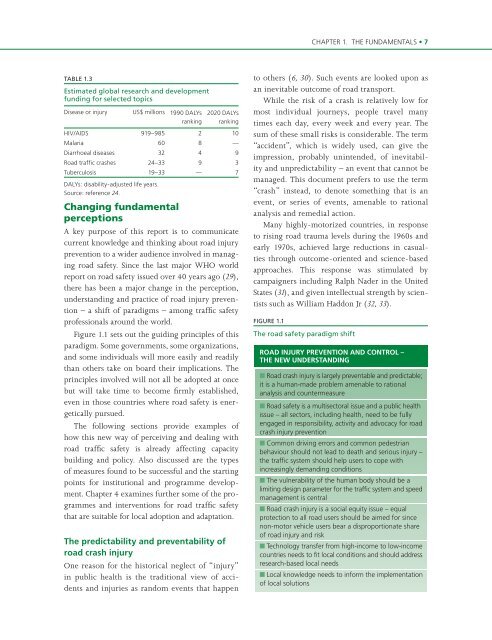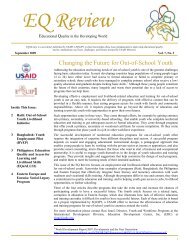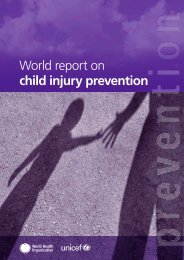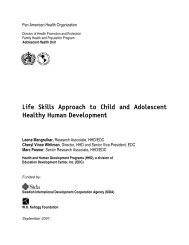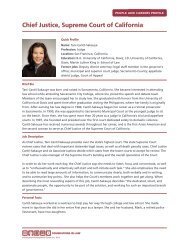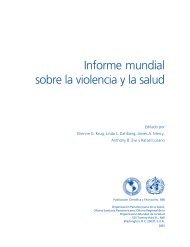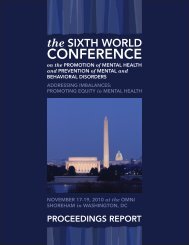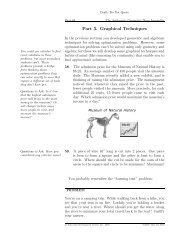World report on road traffic injury prevention edited by M ... - teach-vip
World report on road traffic injury prevention edited by M ... - teach-vip
World report on road traffic injury prevention edited by M ... - teach-vip
Create successful ePaper yourself
Turn your PDF publications into a flip-book with our unique Google optimized e-Paper software.
CHAPTER 1. THE FUNDAMENTALS • 7<br />
TABLE 1.3<br />
Estimated global research and development<br />
funding for selected topics<br />
Disease or <strong>injury</strong> US$ milli<strong>on</strong>s 1990 DALYs<br />
ranking<br />
2020 DALYs<br />
ranking<br />
HIV/AIDS 919–985 2 10<br />
Malaria 60 8 —<br />
Diarrhoeal diseases 32 4 9<br />
Road <strong>traffic</strong> crashes 24–33 9 3<br />
Tuberculosis 19–33 — 7<br />
DALYs: disability-adjusted life years.<br />
Source: reference 24.<br />
Changing fundamental<br />
percepti<strong>on</strong>s<br />
A key purpose of this <str<strong>on</strong>g>report</str<strong>on</strong>g> is to communicate<br />
current knowledge and thinking about <strong>road</strong> <strong>injury</strong><br />
preventi<strong>on</strong> to a wider audience involved in managing<br />
<strong>road</strong> safety. Since the last major WHO world<br />
<str<strong>on</strong>g>report</str<strong>on</strong>g> <strong>on</strong> <strong>road</strong> safety issued over 40 years ago (29),<br />
there has been a major change in the percepti<strong>on</strong>,<br />
understanding and practice of <strong>road</strong> <strong>injury</strong> preventi<strong>on</strong><br />
– a shift of paradigms – am<strong>on</strong>g <strong>traffic</strong> safety<br />
professi<strong>on</strong>als around the world.<br />
Figure 1.1 sets out the guiding principles of this<br />
paradigm. Some governments, some organizati<strong>on</strong>s,<br />
and some individuals will more easily and readily<br />
than others take <strong>on</strong> board their implicati<strong>on</strong>s. The<br />
principles involved will not all be adopted at <strong>on</strong>ce<br />
but will take time to become firmly established,<br />
even in those countries where <strong>road</strong> safety is energetically<br />
pursued.<br />
The following secti<strong>on</strong>s provide examples of<br />
how this new way of perceiving and dealing with<br />
<strong>road</strong> <strong>traffic</strong> safety is already affecting capacity<br />
building and policy. Also discussed are the types<br />
of measures found to be successful and the starting<br />
points for instituti<strong>on</strong>al and programme development.<br />
Chapter 4 examines further some of the programmes<br />
and interventi<strong>on</strong>s for <strong>road</strong> <strong>traffic</strong> safety<br />
that are suitable for local adopti<strong>on</strong> and adaptati<strong>on</strong>.<br />
The predictability and preventability of<br />
<strong>road</strong> crash <strong>injury</strong><br />
One reas<strong>on</strong> for the historical neglect of “<strong>injury</strong>”<br />
in public health is the traditi<strong>on</strong>al view of accidents<br />
and injuries as random events that happen<br />
to others (6, 30). Such events are looked up<strong>on</strong> as<br />
an inevitable outcome of <strong>road</strong> transport.<br />
While the risk of a crash is relatively low for<br />
most individual journeys, people travel many<br />
times each day, every week and every year. The<br />
sum of these small risks is c<strong>on</strong>siderable. The term<br />
“accident”, which is widely used, can give the<br />
impressi<strong>on</strong>, probably unintended, of inevitability<br />
and unpredictability – an event that cannot be<br />
managed. This document prefers to use the term<br />
“crash” instead, to denote something that is an<br />
event, or series of events, amenable to rati<strong>on</strong>al<br />
analysis and remedial acti<strong>on</strong>.<br />
Many highly-motorized countries, in resp<strong>on</strong>se<br />
to rising <strong>road</strong> trauma levels during the 1960s and<br />
early 1970s, achieved large reducti<strong>on</strong>s in casualties<br />
through outcome-oriented and science-based<br />
approaches. This resp<strong>on</strong>se was stimulated <strong>by</strong><br />
campaigners including Ralph Nader in the United<br />
States (31), and given intellectual strength <strong>by</strong> scientists<br />
such as William Hadd<strong>on</strong> Jr (32, 33).<br />
FIGURE 1.1<br />
The <strong>road</strong> safety paradigm shift<br />
ROAD INJURY PREVENTION AND CONTROL –<br />
THE NEW UNDERSTANDING<br />
■ Road crash <strong>injury</strong> is largely preventable and predictable;<br />
it is a human-made problem amenable to rati<strong>on</strong>al<br />
analysis and countermeasure<br />
■ Road safety is a multisectoral issue and a public health<br />
issue – all sectors, including health, need to be fully<br />
engaged in resp<strong>on</strong>sibility, activity and advocacy for <strong>road</strong><br />
crash <strong>injury</strong> preventi<strong>on</strong><br />
■ Comm<strong>on</strong> driving errors and comm<strong>on</strong> pedestrian<br />
behaviour should not lead to death and serious <strong>injury</strong> –<br />
the <strong>traffic</strong> system should help users to cope with<br />
increasingly demanding c<strong>on</strong>diti<strong>on</strong>s<br />
■ The vulnerability of the human body should be a<br />
limiting design parameter for the <strong>traffic</strong> system and speed<br />
management is central<br />
■ Road crash <strong>injury</strong> is a social equity issue – equal<br />
protecti<strong>on</strong> to all <strong>road</strong> users should be aimed for since<br />
n<strong>on</strong>-motor vehicle users bear a disproporti<strong>on</strong>ate share<br />
of <strong>road</strong> <strong>injury</strong> and risk<br />
■ Technology transfer from high-income to low-income<br />
countries needs to fit local c<strong>on</strong>diti<strong>on</strong>s and should address<br />
research-based local needs<br />
■ Local knowledge needs to inform the implementati<strong>on</strong><br />
of local soluti<strong>on</strong>s


